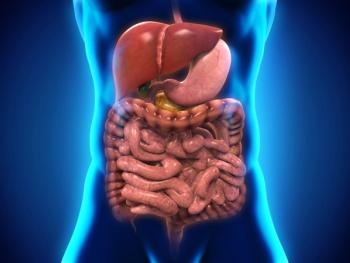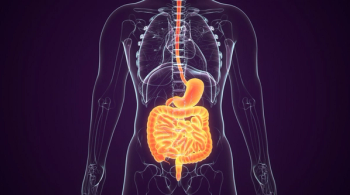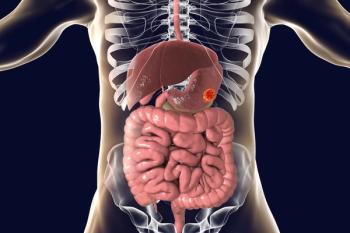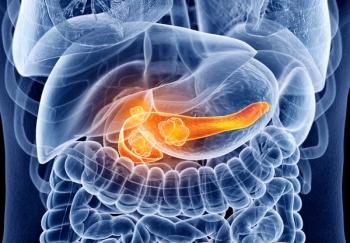
- ONCOLOGY Vol 19 No 3
- Volume 19
- Issue 3
Commentary (Ellis): The Horizon of Antiangiogenic Therapy for Colorectal Cancer
In this issue of ONCOLOGY, Olszewski,Grossbard, and Kozuchprovide an excellent overview ofthe role of antiangiogenic therapy inthe treatment of patients with metastaticcolorectal cancer. The authorshave brought several important issuesto the forefront that warrant furtherdiscussion, and these issues will beaddressed in this commentary.
In this issue of ONCOLOGY, Olszewski, Grossbard, and Kozuch provide an excellent overview of the role of antiangiogenic therapy in the treatment of patients with metastatic colorectal cancer. The authors have brought several important issues to the forefront that warrant further discussion, and these issues will be addressed in this commentary. The authors have appropriately emphasized that adding bevacizumab (Avastin) to standard chemotherapy leads to a synergistic effect with regard to response rates in patients with metastatic colorectal cancer. In contrast, single-agent bevacizumab has not been found to lead to responses in patients with metastatic colorectal cancer in phase I clinical trials. The addition of bevacizumab to chemotherapy (IFL [irinotecan (Camptosar), fluorouracil (5-FU), leucovorin] or 5-FU/leucovorin) in patients with metastatic colorectal cancer has increased response rates by ~10% over chemotherapy alone. This observation is consistent across several disease types including breast carcinoma (randomized phase III trial comparing capecitabine [Xeloda] vs capecitabine plus bevacizumab) and a phase II trial in pancreatic cancer (vs historical controls). Mechanisms of Action
The authors raise the point that antivascular endothelial growth factor (VEGF) therapy may have diverse effects on the vasculature that are distinct from inhibition of endothelial cell proliferation ("sprouting angiogenesis"). In fact, VEGF was first identified as "vascular permeability factor," as this protein has the capacity to induce permeability that is 50,000-fold that of histamine (the gold standard for permeability induction). As outlined in several review articles (referenced at the end of this commentary), this increase in permeability can lead to an increase in interstitial pressure. High tumor interstitial pressures can inhibit delivery of therapeutic agents. It follows that inhibition of VEGF can decrease permeability and, in turn, decrease tumor interstitial pressure. This has been demonstrated in a number of preclinical trials, and the authors of this ONCOLOGY review summarize results from the clinical trial of Willett et al confirming this finding in patients. Although it is counterintuitive, it is possible that anti-VEGF therapy can actually improve the efficiency of blood flow and, thus, drug delivery. Anti-VEGF therapy may have multiple mechanisms of action including inhibition of new vessel formation, "normalization" of the vasculature, and decreased interstitial pressure, the latter two possibly providing for improved drug delivery. Another mechanism of action of anti-VEGF therapy may be a direct effect on tumor cell function. Recent studies from my laboratory have demonstrated that VEGF receptor-1 is present and functional on colorectal cancer cells, and inhibition of this function can inhibit tumor cell migration and invasion. Thus anti-VEGF therapy may not only affect the vasculature, but may have direct effects on tumor cells. Many authors have stated that VEGF is "specific for endothelial cell function," but the recent data alluded to above suggest that VEGF may have more pluripotent activities affecting various cell types within a tumor mass. Clinical Development
The mechanism of action of anti- VEGF therapy has tremendous implications for its further development and use in clinical trials. For example, if anti-VEGF therapy improves the effects of chemotherapy by altering interstitial tumor pressure, then it is unlikely that anti-VEGF therapy will be effective in the adjuvant setting. Although it was initially hypothesized that anti-VEGF therapy was cytostatic, this has not been demonstrated in any trials in colorectal cancer (although admittedly no trial was designed to critically assess the efficacy of single-agent anti-VEGF therapy in a homogeneous population of colorectal cancer patients). With the results of the MOSAIC trial (Multicenter International Study of Oxaliplatin/Fluorouracil/Leucovorin in the Adjuvant Treatment of Colon Cancer) being so impressive, it would be difficult to improve upon this with the addition of anti-VEGF therapy. Furthermore, with the increased incidence of arterial thrombotic events recently recognized in bevacizumab trials, one must assess the risks vs benefits of adding anti-VEGF therapy to current therapeutic regimens, as the long-term effects (> 5 years) of anti-VEGF therapy are unknown. Al- ternatively, if anti-VEGF therapy sensitizes tumor cells (or endothelial cells) to the effects of chemotherapy, then it is possible that the addition of anti- VEGF therapy to current chemotherapeutic regimens may further improve the efficacy of adjuvant therapy. The implementation of trials utilizing bevacizumab in the adjuvant setting will answer some of these questions, but careful evaluation of the interim safety analysis is critical. Optimal Dose
Another issue raised by the authors is that of the dose of bevacizumab. There is controversy regarding the existence of a maximum tolerated dose of bevacizumab. In a phase II trial in patients with breast carcinoma, Sledge observed the dose-limiting toxicity of severe headaches in patients who received bevacizumab at 20 mg/kg. In current clinical trials, the maximum dose utilized is 15 mg/kg. In the accompanying review, the authors summarize data from the randomized phase II trial in colorectal cancer, where patients in the low-dose bevacizumab arm (5 mg/kg bevacizumab plus 5-FU/leucovorin) appeared to benefit greater than these patients in the high-dose arm (10 mg/kg bevacizumab plus 5-FU/leucovorin). However, the authors appropriately point out that the outcome of the study was difficult to interpret because the lowdose bevacizumab arm was composed of a higher proportion of women and patients with a better performance status than those in the high-dose arm. Thus, the 5-mg/kg dose was chosen for the pivotal, randomized phase III study of IFL with or without bevacizumab that eventually led to US Food and Drug Administration (FDA) approval. However, in the Eastern Cooperative Oncology Group (ECOG) 3200 study, (FOLFOX4 [5-FU, leucovorin, oxaliplatin (Eloxatin)]with or without bevacizumab in second-line therapy), the dose chosen was 10 mg/kg. The issue of the optimal biologic dose of bevacizumab is one that has come under scrutiny since the publication of the phase II randomized trial by Kabbinavar. However, it must be recognized that in all other trials with bevacizumab, the higher dose appeared to afford the greatest efficacy. Furthermore, in preclinical trials with anti-VEGF agents (including bevacizumab), the higher dose afforded the greatest efficacy. In the ECOG 3200 trial, patients receiving bevacizumab plus FOLFOX4 had an improvement in median survival of 1.8 months (12.5 vs 10.7 mo) vs FOLFOX4 alone. These data do not clarify dosing, but do demonstrate that several different doses of bevacizumab added to chemotherapy increased efficacy. With regard to anti-VEGF dosing, it is important to point out that the use of another VEGF-receptor inhibitor, PTK787, demonstrated a dose-dependent change in perfusion/ permeability parameters on dynamic contrast-enhanced magnetic resonance imaging (DCE-MRI) in a phase I trial in patients with metastatic colorectal cancer to the liver. Overall, we may never be able to sort out small differences in efficacy between the 5- and 10-mg/kg doses due to the impracticality of conducting a clinical trial to address this issue. Final Considerations
It is critically important to emphasize that one must consider bevacizumab as a component of the antineoplastic regimen when used to treat patients with metastatic colorectal cancer. Use of bevacizumab as a single agent has not been approved by the FDA for any indication as of February 2005. (However, singleagent activity in second-line therapy will be reported at the 2005 meeting of the American Society of Clinical Oncology.) The fact that bevacizumab is a component of an antineoplastic regimen containing chemotherapy makes it extremely difficult to identify markers of sensitivity or resistance to bevacizumab. Perhaps the best marker of efficacy may be derived from functional imaging studies utilizing DCE-MRI. Morgan et al demonstrated that the greatest decrease in the Ki (the permeability/ perfusion coefficient) correlated with patients who had stable disease in a phase I study in patients with liver me- tastasis from colorectal cancer treated with the VEGFreceptor tyrosine kinase inhibitor PTK787. Again, as it is not likely that anti-VEGF therapy will be utilized as a single agent in patients with metastatic colorectal cancer, it is difficult to determine the utility of these studies outside of a clinical trial. Overall, this is an incredibly exciting time in the field of targeted therapies and, specifically, in the field of antiangiogenic therapy. Further preclinical and clinical studies will help determine the best utilization of these agents and hopefully continue to improve the therapeutic index and overall survival for patients with metastatic colorectal cancer and other diseases.
Disclosures:
Dr. Ellis is a consultant for and receives grant support from ImClone Systems.
References:
Fan F, Wey JS, McCarty MF, et al: Expression and function of vascular endothelial growth factor receptor–1 on human colorectal cancer cells. Oncogene. In press.
Heldin CH, Rubin K, Pietras K, et al: High interstitial fluid pressure-an obstacle in cancer therapy. Nat Rev Cancer 4:806-813, 2004.
Hicklin DJ, Ellis LM: Role of the vascular endothelial growth factor pathway in tumor growth and angiogenesis. J Clin Oncol, 23:1- 17, 2005.
Jain RK: Normalization of the tumor vasculature and microenvironment. Science, 307:58- 62, 2005.
Jain RK: Tumor angiogenesis and accessibility: Role of vascular endothelial growth factor. Semin Oncol 29:3-9, 2002.
Kerbel RS, Kamen BA: The anti-angiogenic basis of metronomic chemotherapy. Nat Rev Cancer 4:423-436, 2004.
Lee CG, Heijn M, di Tomaso E, et al: Ant VEGF treatment augments tumor radiation response under normoxic or hypoxic conditions. Cancer Res 60:5565-5570, 2000.
Morgan B, Thomas AL, Drevs J, et al: Dynamic contrast-enhanced magnetic resonance imaging as a biomarker for the pharmacological response of PTK787/ZK 222584, an inhibitor of the vascular endothelial growth factor receptor tyrosine kinases, in patients with advanced colorectal cancer and liver metastases: Results from two phase I studies. J Clin Oncol 21:3955-3964, 2003.
Sledge GW Jr: Vascular endothelial growth factor in breast cancer: Biologic and therapeutic aspects. Semin Oncol 29(3 suppl 11):104- 110, 2002.
Wey JS, Stoeltzing O, Ellis LM: Vascular endothelial growth factor receptors: Expression and function in solid tumors. Clin Advances Hematol Oncol 2:37-45, 2004.
Willett C, Boucher Y, diTomaso E, et al: Direct evidence that the VEGF-specific antibody bevacizumab has antivascular effects in human rectal cancer. Nat Med 10:145-147, 2004.
Articles in this issue
almost 21 years ago
Commentary (Malkowicz): Organ Preservation in Muscle-Invasive Bladder Canceralmost 21 years ago
Commentary (Shipley): Organ Preservation in Muscle-Invasive Bladder Canceralmost 21 years ago
Combined-Modality Treatment for Operable Pancreatic Adenocarcinomaalmost 21 years ago
The Horizon of Antiangiogenic Therapy for Colorectal CancerNewsletter
Stay up to date on recent advances in the multidisciplinary approach to cancer.
































































































